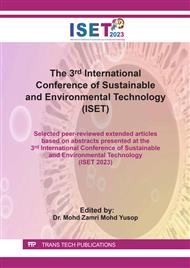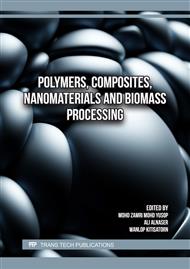[1]
S. Ahualli, G. R. Iglesias, W. Wachter, M. Dulle, D. Minami, and O. Glatter, "Adsorption of anionic and cationic surfactants on anionic colloids: Supercharging and destabilization," Langmuir, vol. 27, no. 15, p.9182–9192, 2011.
DOI: 10.1021/la201242d
Google Scholar
[2]
H. Shamsijazeyi, C. A. Miller, M. S. Wong, J. M. Tour, and R. Verduzco, "Polymer-coated nanoparticles for enhanced oil recovery," J. Appl. Polym. Sci., vol. 131, no. 15, p.1–13, 2014.
DOI: 10.1002/app.40576
Google Scholar
[3]
T. Sharma, G. S. Kumar, and J. S. Sangwai, "Comparative effectiveness of production performance of Pickering emulsion stabilized by nanoparticle-surfactant-polymerover surfactant-polymer (SP) flooding for enhanced oil recoveryfor Brownfield reservoir," J. Pet. Sci. Eng., vol. 129, p.221–232, 2015.
DOI: 10.1016/j.petrol.2015.03.015
Google Scholar
[4]
N. Saleh, H. J. Kim, T. Phenrat, K. Matyjaszewski, R. D. Tilton, and G. V. Lowry, "Ionic strength and composition affect the mobility of surface-modified fe 0< nanoparticles in water-saturated sand columns," Environ. Sci. Technol., vol. 42, no. 9, p.3349–3355, 2008.
DOI: 10.1021/es071936b
Google Scholar
[5]
V. Krishnakumar and R. Elansezhian, "Dispersion stability of zinc oxide nanoparticles in an electroless bath with various surfactants," Mater. Today Proc., vol. 51, p.369–373, 2021.
DOI: 10.1016/j.matpr.2021.05.467
Google Scholar
[6]
I. Fernando, T. Qian, and Y. Zhou, "Long term impact of surfactants & polymers on the colloidal stability, aggregation and dissolution of silver nanoparticles," Environ. Res., vol. 179, no. September, p.108781, 2019.
DOI: 10.1016/j.envres.2019.108781
Google Scholar
[7]
J. E. Azadgoleh, R. Kharrat, N. Barati, and A. Sobhani, "Stability of Silica Nanoparticle Dispersion in Brine Solution: an Experimental Study," Iran. J. Oil Gas Sci. Technol., vol. 3, no. 4, p.26–40, 2014, [Online]. Available: http://ijogst.put.ac.ir.
Google Scholar
[8]
G. Xia, H. Jiang, R. Liu, and Y. Zhai, "Effects of surfactant on the stability and thermal conductivity of Al 2O3/de-ionized water nanofluids," Int. J. Therm. Sci., vol. 84, p.118–124, 2014.
DOI: 10.1016/j.ijthermalsci.2014.05.004
Google Scholar
[9]
Y. Zhai, L. Li, J. Wang, and Z. Li, "Evaluation of surfactant on stability and thermal performance of Al2O3-ethylene glycol (EG) nanofluids," Powder Technol., vol. 343, p.215–224, 2019.
DOI: 10.1016/j.powtec.2018.11.051
Google Scholar
[10]
B. Sohrabi, N. Poorgholami-Bejarpasi, and N. Nayeri, "Dispersion of carbon nanotubes using mixed surfactants: Experimental and molecular dynamics simulation studies," J. Phys. Chem. B, vol. 118, no. 11, p.3094–3103, 2014.
DOI: 10.1021/jp407532j
Google Scholar
[11]
X. Li, C. Pu, Y. Bai, and F. Huang, "Effect of surfactant types on the foam stability of multiwalled carbon nanotube stabilized foam," Colloids Surfaces A Physicochem. Eng. Asp., vol. 648, no. June, 2022.
DOI: 10.1016/j.colsurfa.2022.129389
Google Scholar
[12]
B. S. Necula, I. Apachitei, L. E. Fratila-Apachitei, C. Teodosiu, and J. Duszczyk, "Stability of nano-/microsized particles in deionized water and electroless nickel solutions," J. Colloid Interface Sci., vol. 314, no. 2, p.514–522, 2007.
DOI: 10.1016/j.jcis.2007.05.073
Google Scholar
[13]
R. Sass, Encyclopedia of Applied Electrochemistry. 2014.
Google Scholar
[14]
B. White, S. Banerjee, S. O. Brien, N. J. Turro, and I. P. Herman, "Zeta-Potential Measurements of Surfactant-Wrapped Individual Single-Walled Carbon Nanotubes," vol. 2, no. 1, p.13684–13690, 2007.
DOI: 10.1021/jp070853e
Google Scholar
[15]
T. Kavinkumar and S. Manivannan, "Synthesis, Characterization and Gas Sensing Properties of Graphene Oxide-Multiwalled Carbon Nanotube Composite," J. Mater. Sci. Technol., vol. 32, no. 7, p.626–632, 2016.
DOI: 10.1016/j.jmst.2016.03.017
Google Scholar
[16]
B. B. Feng et al., "Performance of graphene dispersion by using mixed surfactants," Mater. Res. Express, vol. 7, no. 9, 2020.
DOI: 10.1088/2053-1591/abb2ca
Google Scholar
[17]
Y. Wang et al., "Effect of hydrophobically modified SiO2 nanoparticles on the stability of water-based SDS foam," Arab. J. Chem., vol. 13, no. 9, p.6942–6948, 2020.
DOI: 10.1016/j.arabjc.2020.06.037
Google Scholar
[18]
H. H. M. Asnan et al., "Surfactant-bound fe3 o4 nanoparticles as catalyst support: Synthesis and physicochemical properties," Malaysian J. Anal. Sci., vol. 23, no. 5, p.781–788, 2019.
Google Scholar
[19]
S. Paryoto, Y. Romdoni, I. Kurnia, O. Muraza, and M. Khalil, "Synergy of surfactant mixtures and Fe3O4 nanoparticles for Enhanced oil recovery (EOR)," Inorg. Chem. Commun., vol. 155, no. February, p.111125, 2023.
DOI: 10.1016/j.inoche.2023.111125
Google Scholar
[20]
S. Al-Anssari, M. Arif, S. Wang, A. Barifcani, and S. Iglauer, "Stabilising nanofluids in saline environments," J. Colloid Interface Sci., vol. 508, no. August, p.222–229, 2017.
DOI: 10.1016/j.jcis.2017.08.043
Google Scholar
[21]
A. Muhsan, U. Ishtiaq, A. Rozali, N. Mohamed, and T. Albarody, "Nanocarbon-based enhanced squeeze treatment for improved scale management," IOP Conf. Ser. Mater. Sci. Eng., vol. 458, no. 1, 2018.
DOI: 10.1088/1757-899X/458/1/012044
Google Scholar



